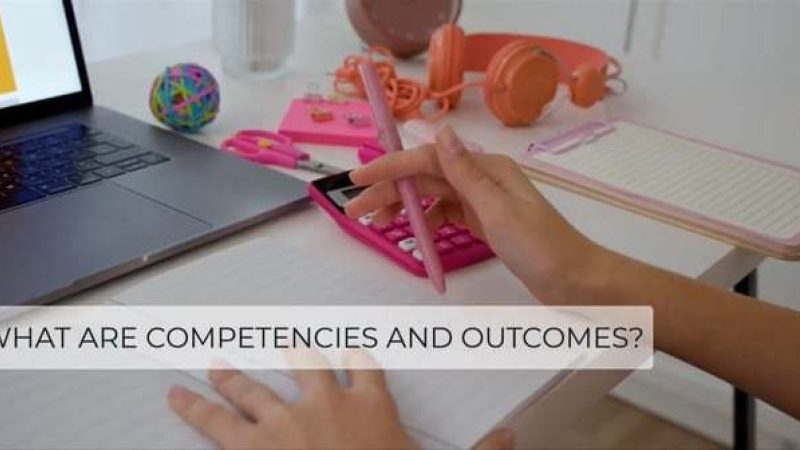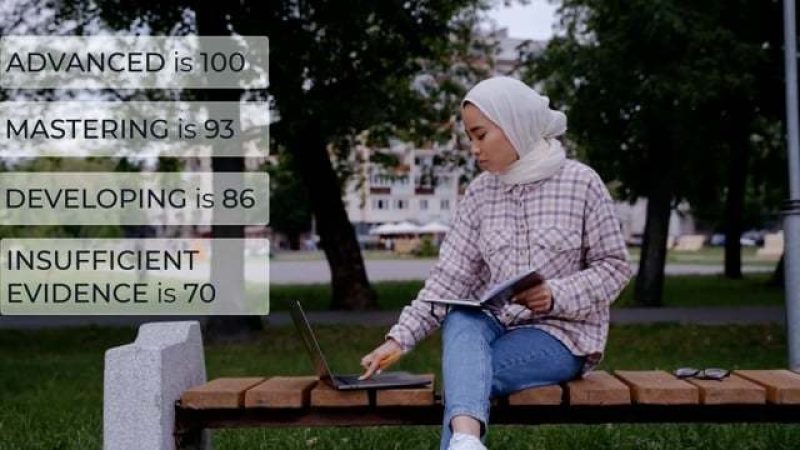How We Grade and Why: Five Steps for Fusing CBL and Grading
At GOA, we believe that students grow and learn when they have clarity about the goals they are trying to achieve, when they receive actionable feedback aligned to those goals, and when they have multiple opportunities to apply that feedback, to improve their skills, and ultimately to transfer their newfound skills and understandings to different contexts. This is why we have embraced competency-based learning as a framework for our student program courses and have spent the last five years honing that approach. Nevertheless, our students, teachers, and member schools occupy a particular place in the wider world, and as a result, GOA is faced with a conundrum: we are committed to competency-based learning, yet must deliver reports to a diverse membership that requires grades to be reported as a percentage (0-100).
The GOA team has worked hard to fuse competency-based pedagogy with a traditional grades-based reporting system. Students and teachers are engaged in ongoing conversations about competencies, outcomes, and feedback - and as they progress toward proficiency with those competencies, they see how their learning impacts the grade that will ultimately sit on their transcript. This post outlines both the how and the why of our competency-based approach to grading with five steps schools can take to move into a competency-based framework while assigning traditional grades.
1. Use Proficiency Ratings, Not Points
Teachers at GOA choose between four proficiency levels (not 100) when they look at a piece of work and consider the evidence they see of learning in that work. For each of the outcomes targeted on a particular assignment, the work is either Advanced, Mastering, Developing, or Insufficient Evidence. As Guskey and others have rightly pointed out, few teachers can look at many students' work and accurately and consistently distinguish between work that deserves an 88 and work that deserves an 89. The more interstices there are between the grading designations a school uses, the more open doors it creates for error and implicit bias to permeate its classes. When you have a team of 100+ teachers as diverse as GOA's, the potential for inconsistency and actual harm is even greater (see Feldman Chapter 7 for a larger discussion on this).
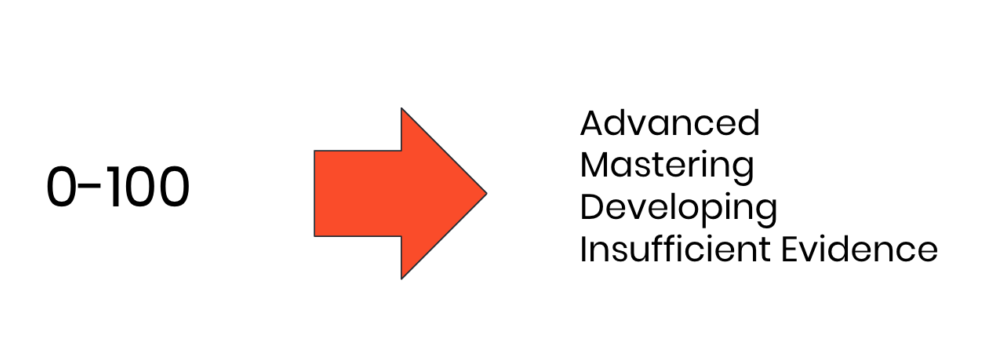
At GOA, we have four proficiency levels (Advanced, Mastering, Developing, and Insufficient Evidence), and, on the back end, we assign a numeric value to each. Then, we use those numbers to create a grade for each competency that a course seeks to build in students. Essentially, teachers and students are engaging with four proficiency levels via their rubrics, and GOA translates those assessments into a traditional grade, which is the language of most parents, college counselors, and others. In many ways, our approach is similar to standards-based grading (SBG) but with two key differences. First, rather than communicating a grade for each learning outcome (or standard) as one would in an SBG environment, we group them under broader, more transferable competencies and communicate a grade for the competency. Most courses focus on three-to-five competencies. Secondly, all of our outcomes and competencies are intended to be applied across units and several courses. That is to say, contrary to what is often the case with standards in SBG, none of our outcomes or competencies are specific to a particular unit of content. The result is that as students see their assessments on rubrics growing from Insufficient Evidence to Developing to Mastering to Advanced throughout the course, they likewise see their competency grades grow from the 70s into the 90s in a way that aligns with the cultural expectations at their schools (i.e., our grade distribution is akin to elective courses at most member schools).
What are competencies and outcomes?
2. Make Collaborative Norming Part of the Grading Process
In order to feel confident in the accuracy and consistency of how we are assessing students leading up to a GOA semester, all course teams norm the competencies and outcomes that will be used to assess student work throughout the term. Similar to the approaches that Berger et al. advocate for in Leaders of Their Own Learning, all sections of a given GOA course use the same rubrics on the same assignments, and the teaching team works out ahead of time what the four proficiency levels will look like on the assignments in question. What will it mean for a student to be Developing on a given outcome when she turns in her project at the end of Module 2? What might Mastering work look like? Here is an example of the template we use to help teachers arrive at a shared understanding. This particular example is from our Medical Problem Solving team.
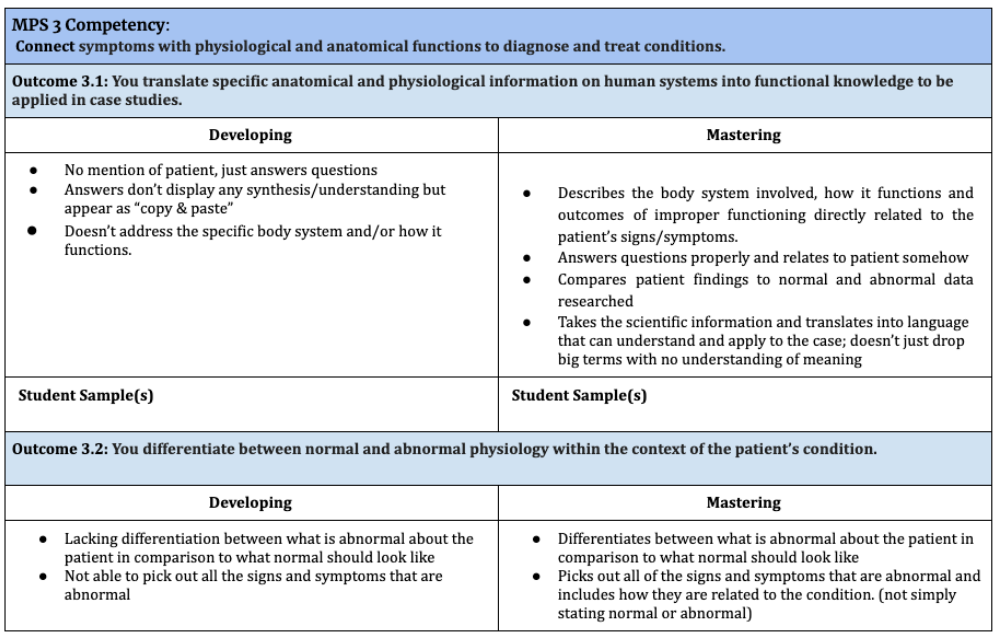
In addition, led by their Learning Design Coaches, our teams work together on language that teachers can draw from when working on their mid-semester and end-of-semester reports (see an example below). Note that the blue boxes call out both the traditional grade and the CBL proficiency ratings on the report. The teaching teams create a menu of normed bullet points for use under "Evidence of Mastery" and "Areas for Growth," and teachers can freehand that feedback for particular students where appropriate. This is all difficult, time-consuming work, but organizations need to do it in the service of equity and accuracy in grading.
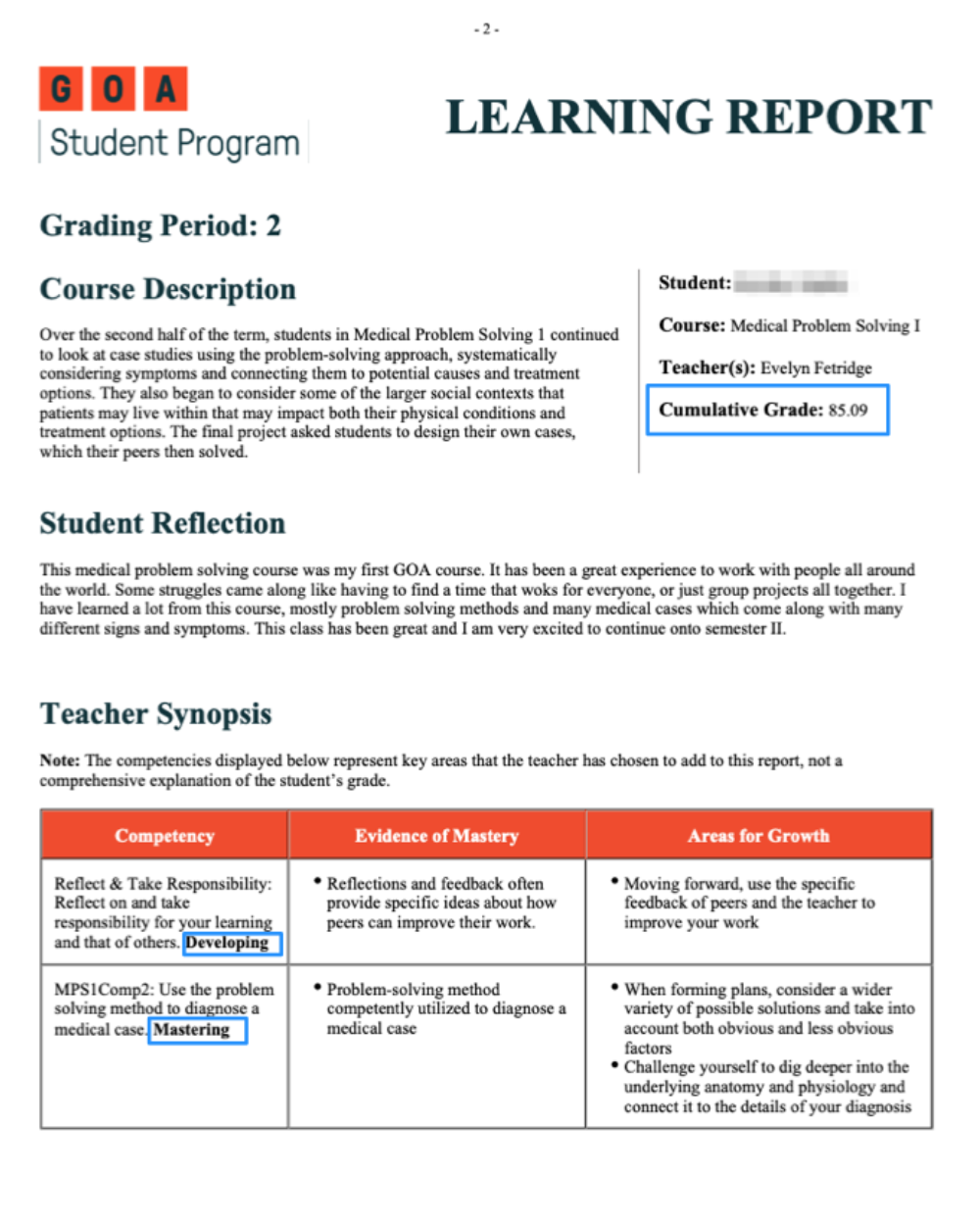
3. Step Away from Assignment Level Grades
With the transfer of skills as an important goal, we focus on assessing outcomes and competencies over time rather than assigning grades to assignments as singular events. Where there is seldom an outside audience for assignment-level grades, teachers and schools can move away from them relatively easily while strengthening their approach to feedback. Norford and Marzano refer to this as the principle of unidimensionality. If an assessment seeks to measure two or more outcomes, we assess each of those outcomes separately through a rubric coupled with actionable feedback. Putting an 88 or a B+ at the top of the assignment, in addition, is superfluous and only serves to muddle the feedback. Two students who earned an 88 likely had very different and jagged performances on that assessment. It causes students to turn to one another when work is handed back and ask, "What did you get?" rather than "How well did you use conditions and loops in your programming?", which, in the example rubric below, is clearly the conversation that the teacher wants the students to be having.
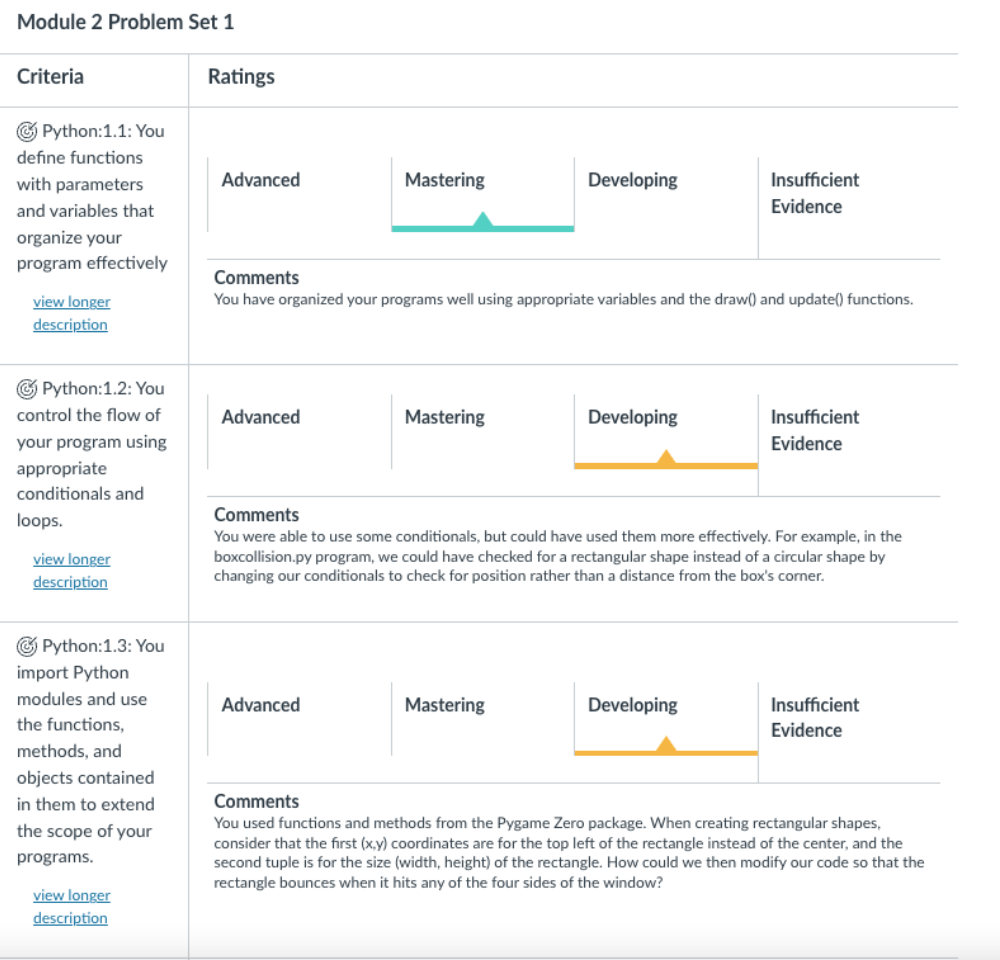
In short, the rubric above assigns three grades, one for each outcome the assignment focuses on, without mixing apples and oranges and lumping them together into one assignment-level grade. Instead, we group each of the outcome assessments from this rubric with assessments of outcomes from the same competency area and show students a constantly developing and growing competency grade for each of the competencies the course purports to be helping students build. It shows up for students at the bottom of their grade view in Canvas, and those competency grades update nightly to give the most accurate possible representation of their current skills.
How Competencies Impact Your Grade
4. Give More Credit for Progress and Recency Instead of Averaging Scores
Thus, a student has earned a series of proficiency ratings associated with a learning outcome, and GOA assigns numeric values to those assessments - what then? One option would be to default to the traditional practice of averaging those numbers and slapping them on a report card. That said, researchers like Joe Feldman and others make clear that grades based on pure averages can be inequitable in that they result in two students who have ultimately attained the same skills and understandings walking away from the course with very different grades (actually, hat tip to Peter Gow who was preaching this gospel in new teacher orientation at BCDSchool many years ago!). Some schools in standards-based or mastery-based environments base grades on the most recent demonstration of learning. At GOA, we use decaying averages so that a student's grade on a particular learning outcome weighs the most recent assessment more heavily than all of the previous attempts. The result is that competency grades at GOA grow and improve as the students grow and improve (without turning the final assessment into a high-stakes exam). In the end, the grades that schools report should be prepared with the freshest ingredients available (students' skills at a moment in time) rather than serving something up using the failed midterm exam that has been wilting in the back of more traditional gradebooks.
If you are a Canvas user, these settings are helpful.
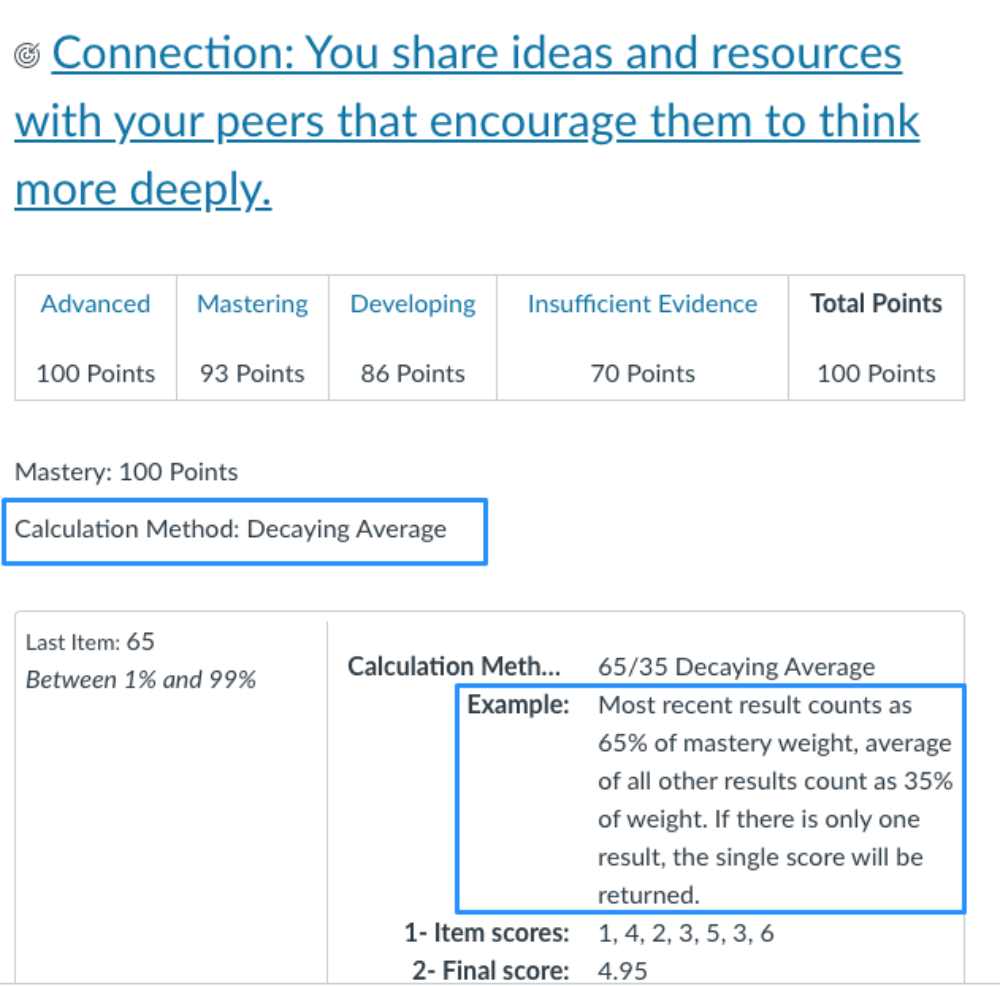
5. Don't Use Grades as Rewards and Punishments Related to Behaviors
In a similar vein, significant research shows that assessment policies that wrap student behaviors (turning in work on time, vaguely defined class participation, 0s for missing assignments) and their academic skills together in one grade systematically disadvantages students whose personal lives are more likely to interfere with their learning (and, of course, those students are more likely to be economically, racially, ethnically or otherwise marginalized). See Chapter 9 in Joe Feldman's book for a full account. For example, if a student fails to turn in his Spanish project (for whatever reason) - it is likely NOT because his Spanish is weak, but rather because his time management skills need work. Yet, if we give him a 0 on that assignment or take off 10% when it is a day late, we are clouding what we communicate about his academic skills (the grade) with a penalty associated with unrelated behavior.
At GOA, we are transitioning away from the use of grades as carrots and sticks to influence these kinds of behaviors. We no longer use grades of 0 to influence compliance, and as of June 2022, we will no longer be penalizing late work using grades. It remains important that students meet deadlines and be accountable to teachers and peers - and we communicate clearly with students and schools about when this is and is not happening. Grades, however, should reflect the student's proficiency with the competencies that the course is focused on. In our context, the only real caveat to that position is that in rare cases, even in a competency-based framework, when a student has not submitted sufficient work for the teacher to make a professional judgment on their competencies, when all of the student support resources at our disposal are exhausted, that student doesn't pass the course and is invited to pick it up again in a future semester.
One More Note on Completing Assignments
In short, many of us have been doing the work of re-orienting our schools toward a competency-based approach to teaching and learning because of the way that it mirrors the way people learn in real life and the opportunities that it provides for increased student agency, equity, and the transfer of key skills and understandings from one setting to another. If you and your organization have laid the groundwork and are beginning to run up against what feels like insurmountable institutional barriers around grading and reporting - know that by using these five approaches, you can begin to create a harmonious coexistence between grading for external constituencies and using competency-based learning to keep the focus on feedback and learning in your classes.
GOA serves students, teachers, and leaders and is comprised of member schools from around the world, including independent, international, charter, and public schools. Learn more about Becoming a Member. Our professional learning opportunities are open to any educator or school team. Follow us on LinkedIn and Twitter. To stay up to date on GOA learning opportunities, sign up for our newsletter.

